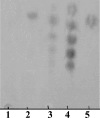Novel bifunctional alpha-L-arabinofuranosidase/xylobiohydrolase (ABF3) from Penicillium purpurogenum
- PMID: 20562284
- PMCID: PMC2916492
- DOI: 10.1128/AEM.00214-10
Novel bifunctional alpha-L-arabinofuranosidase/xylobiohydrolase (ABF3) from Penicillium purpurogenum
Abstract
The soft rot fungus Penicillium purpurogenum grows on a variety of natural substrates and secretes various isoforms of xylanolytic enzymes, including three arabinofuranosidases. This work describes the biochemical properties as well as the nucleotide and amino acid sequences of arabinofuranosidase 3 (ABF3). This enzyme has been purified to homogeneity. It is a glycosylated monomer with a molecular weight of 50,700 and can bind cellulose. The enzyme is active with p-nitrophenyl alpha-L-arabinofuranoside and p-nitrophenyl beta-D-xylopyranoside with a K(m) of 0.65 mM and 12 mM, respectively. The enzyme is active on xylooligosaccharides, yielding products of shorter length, including xylose. However, it does not hydrolyze arabinooligosaccharides. When assayed with polymeric substrates, little arabinose is liberated from arabinan and debranched arabinan; however, it hydrolyzes arabinose and releases xylooligosaccharides from arabinoxylan. Sequencing both ABF3 cDNA and genomic DNA reveals that this gene does not contain introns and that the open reading frame is 1,380 nucleotides in length. The deduced mature protein is composed of 433 amino acids residues and has a calculated molecular weight of 47,305. The deduced amino acid sequence has been validated by mass spectrometry analysis of peptides from purified ABF3. A total of 482 bp of the promoter were sequenced; putative binding sites for transcription factors such as CreA (four), XlnR (one), and AreA (three) and two CCAAT boxes were found. The enzyme has two domains, one similar to proteins of glycosyl hydrolase family 43 at the amino-terminal end and a family 6 carbohydrate binding module at the carboxyl end. ABF3 is the first described modular family 43 enzyme from a fungal source, having both alpha-L-arabinofuranosidase and xylobiohydrolase functionalities.
Figures




Similar articles
-
A family 51 alpha-l-arabinofuranosidase from Penicillium purpurogenum: purification, properties and amino acid sequence.Mycol Res. 2008 Aug;112(Pt 8):933-42. doi: 10.1016/j.mycres.2008.01.022. Epub 2008 Feb 16. Mycol Res. 2008. PMID: 18550352
-
Heterologous expression and characterization of α-L-arabinofuranosidase 4 from Penicillium purpurogenum and comparison with the other isoenzymes produced by the fungus.Fungal Biol. 2015 Jul;119(7):641-7. doi: 10.1016/j.funbio.2015.04.001. Epub 2015 Apr 14. Fungal Biol. 2015. PMID: 26058539
-
Penicillium purpurogenum produces two GH family 43 enzymes with β-xylosidase activity, one monofunctional and the other bifunctional: Biochemical and structural analyses explain the difference.Arch Biochem Biophys. 2013 Dec;540(1-2):117-24. doi: 10.1016/j.abb.2013.10.017. Epub 2013 Oct 31. Arch Biochem Biophys. 2013. PMID: 24184421
-
A novel GH43 α-l-arabinofuranosidase of Penicillium chrysogenum that preferentially degrades single-substituted arabinosyl side chains in arabinan.Enzyme Microb Technol. 2014 May 10;58-59:80-6. doi: 10.1016/j.enzmictec.2014.03.005. Epub 2014 Mar 15. Enzyme Microb Technol. 2014. PMID: 24731829
-
Α-L-arabinofuranosidase 3 from Penicillium purpurogenum (ABF3): potential application in the enhancement of wine flavour and heterologous expression of the enzyme.Food Chem. 2012 Sep 15;134(2):888-93. doi: 10.1016/j.foodchem.2012.02.200. Epub 2012 Mar 7. Food Chem. 2012. PMID: 23107704
Cited by
-
Screening of thermotolerant and thermophilic fungi aiming β-xylosidase and arabinanase production.Braz J Microbiol. 2015 Mar 4;45(4):1459-67. doi: 10.1590/s1517-83822014000400042. eCollection 2014. Braz J Microbiol. 2015. PMID: 25763055 Free PMC article.
-
The Role of Arabinogalactan Type II Degradation in Plant-Microbe Interactions.Front Microbiol. 2021 Aug 25;12:730543. doi: 10.3389/fmicb.2021.730543. eCollection 2021. Front Microbiol. 2021. PMID: 34512607 Free PMC article. Review.
-
Distinct actions by Paenibacillus sp. strain E18 α-L-arabinofuranosidases and xylanase in xylan degradation.Appl Environ Microbiol. 2013 Mar;79(6):1990-5. doi: 10.1128/AEM.03276-12. Epub 2013 Jan 18. Appl Environ Microbiol. 2013. PMID: 23335774 Free PMC article.
-
Unlocking the distinctive enzymatic functions of the early plant biomass deconstructive genes in a brown rot fungus by cell-free protein expression.Appl Environ Microbiol. 2024 May 21;90(5):e0012224. doi: 10.1128/aem.00122-24. Epub 2024 Apr 3. Appl Environ Microbiol. 2024. PMID: 38567954 Free PMC article.
-
Biochemical and kinetic characterisation of a novel xylooligosaccharide-upregulated GH43 β-d-xylosidase/α-l-arabinofuranosidase (BXA43) from the probiotic Bifidobacterium animalis subsp. lactis BB-12.AMB Express. 2013 Sep 11;3(1):56. doi: 10.1186/2191-0855-3-56. AMB Express. 2013. PMID: 24025736 Free PMC article.
References
-
- Bainbridge, B. W., C. L. Spreadbury, F. G. Scalise, and J. Cohen. 1990. Improved methods for the preparation of high molecular weight DNA from large and small scale cultures of filamentous fungi. FEMS Microbiol. Lett. 54:113-117. - PubMed
-
- Belancic, A., J. Scarpa, A. Peirano, R. Díaz, J. Steiner, and J. Eyzaguirre. 1995. Penicillium purpurogenum produces several xylanases: purification and properties of two of the enzymes. J. Biotechnol. 41:71-79. - PubMed
-
- Beldman, G., H. A. Schols, S. M. Pitson, M. J. F. Searle-van Leeuwen, and A. G. J. Voragen. 1997. Arabinans and arabinan-degrading enzymes. Adv. Macromol. Carbohydr. Res. 1:1-64.
-
- Bollag, D. M., and S. J. Edelstein. 1991. Protein methods. Wiley-Liss, New York, NY.
-
- Brakhage, A. A., A. Andrianopoulos, M. Kato, S. Steidl, M. A. Davis, N. Tsukagoshi, and M. J. Hynes. 1999. HAP-like CCAAT-binding complexes in filamentous fungi: implications for biotechnology. Fungal Genet. Biol. 27:243-252. - PubMed
Publication types
MeSH terms
Substances
Associated data
- Actions
Grants and funding
LinkOut - more resources
Full Text Sources

